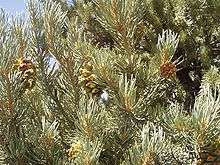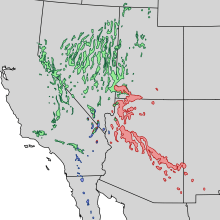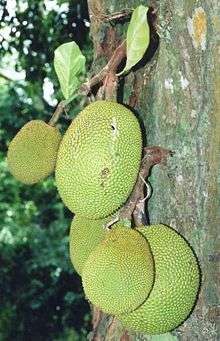Pinyon pine

The pinyon or piñon pine group grows in the southwestern United States and in Mexico. The trees yield edible pinyon nuts, which were a staple of the Native Americans (American Indians), and are still widely eaten. Harvesting techniques of the prehistoric Indians are still being used to today to collect the pinyon seeds for personal use or for commercialization. The pinyon nut or seed is high in fats and calories.
Pinyon wood, especially when burned, has a distinctive fragrance, making it a common wood to burn in chimineas.[1] The pinyon pine trees are also known to influence the soil in which they grow by increasing concentrations of both macronutrients and micronutrients.[2]
Some of the species are known to hybridize, the most notable ones being P. quadrifolia with P. monophylla, and P. edulis with P. monophylla.
Species


Genetic differentiation in the pinyon pine has been observed associated to insect herbivory and environmental stress.[3][4]


There are eight species of true pinyon (Pinus subsection Cembroides):[5]
Pinus cembroides – Mexican pinyon
Pinus orizabensis – Orizaba pinyon
Pinus johannis – Johann's pinyon (includes P. discolor – Border pinyon)
Pinus culminicola – Potosi pinyon
Pinus remota – Texas pinyon or papershell pinyon
Pinus edulis – Two-needle piñon or Colorado pinyon (when grown in Colorado)
Pinus monophylla – Single-leaf pinyon
Pinus quadrifolia – Parry pinyon (includes P. juarezensis).
These additional Mexican species are also related and mostly called pinyons:
Pinus rzedowskii – Rzedowski's pine
Pinus pinceana – Weeping pinyon
Pinus maximartinezii – Big-cone pinyon
Pinus nelsonii – Nelson's pinyon
The three bristlecone pine species of the high mountains of the southwestern United States, and the lacebark pines of Asia are closely related to the pinyon pines.
Pinyon seeds as food for prehistoric Native Americans
The seeds of the pinyon pine, usually called "pine nuts," or simply "piñons" by the Navajo, were an important food for pre-historic Indians living in the mountains of southwestern United States and northern Mexico. The nuts continue to be gathered, eaten, and marketed. All species of pine produce edible seeds, but in North America only pinyon produces seeds large enough to be a major source of food.[6]
The pinyon has probably been a source of food since shortly after the earliest arrival of Homo sapiens in the American southwest, 12,000 or more years ago. In the Great Basin of the United States, archaeological evidence indicates that the range of the pinyon pine expanded northward after the Ice Age, reaching its northernmost (and present) limit in southern Idaho about 4,000 BCE.[7] Hunter/gatherer Indians undoubtedly collected the edible seeds, but, at least in some areas, the pinyon nuts were not harvested and eaten in quantity until about 600 CE. Increased use of pinyon nuts was possibly related to a population increase of humans and a decline in the number of game animals, thereby forcing the Great Basin inhabitants to seek additional sources of food.[8]
The suitability of pinyon seeds as a staple food is reduced because of the unreliability of the harvest. Abundant crops of cones and seeds occur only every two to seven years, averaging a good crop every four years. Years of high production of seed tend to be the same over wide areas of the pinyon range.[9]
Traditional method of harvesting
In 1878, naturalist John Muir described the Indian method of harvesting pinyon seeds in Nevada. In September and October, the harvesters knocked the cones off the pinyon trees with poles, stacked the cones into a pile, put brushwood on top, lit it, and lightly scorched the pinyon cones with fire. The scorching burned off the sticky resin coating the cones and loosened the seeds. The cones were then dried in the sun until the seeds could be easily extracted. Muir said the Indians closely watched the pinyon trees year-round and could predict the scarcity or abundance of the crop months before harvest time.[10] In 1891, B. H. Dutcher observed the harvesting of pinyon seeds by the Panamint Indians (Timbisha people) in the Panamint Range overlooking Death Valley, California. The harvesting method was similar to the foregoing except that the pinyon seeds were extracted immediately after the cones had been scorched in the brushwood fire.[11]
Both the above accounts described a method of extracting the seeds from the green cones. Another method is to leave the cones on the trees until they are dry and brown, then beat the cones with a stick, knocking the cones loose or the seeds loose from the cones which then fall to the ground where they can be collected.[12] The nomadic hunter-gathering people of the Great Basin usually consumed their pinyon seeds during the winter following harvest; the agricultural Pueblo people of the Rio Grande valley of New Mexico could store them for two or three years in underground pits.[13]
Each pinyon cone produces 10 to 30 seeds and a productive stand of pinyon trees in a good year can produce 250 pounds (110 kg) on 1 acre (0.40 ha) of land. An average worker can collect about 22 pounds (10.0 kg) of unshelled pinyon seed in a day's work. Production per worker of 22 pounds of unshelled pinyon seeds—more than one-half that in shelled seeds—amounts to nearly 30,000 calories of nutrition. That is a high yield for the effort expanded by hunter-gatherers. Moreover, the pinyon seeds are high in fat, often in short supply for hunter-gatherers.[14]
Relationship with wildlife
The pinyon jay (Gymnorhinus cyanocephalus) takes its name from the tree, and pinyon nuts form an important part of its diet. It is very important for regeneration of pinyon woods, as it stores large numbers of the seeds in the ground for later use, and excess seeds not used are in an ideal position to grow into new trees. The Mexican jay is also important for the dispersal of some pinyon species, as, less often, is the Clark's nutcracker. Many other species of animal also eat pinyon nuts, without dispersing them.
See also
References
- ↑ "Chiminea Woods: Pinon, Apple, and Hickory—Oh My!".
- ↑ Barth, R.C. (January 1980). "Influence of Pinyon Pine Trees on Soil Chemical and Physical Properties". Soil Science Society of America Journal. 44 (1): 112–114. doi:10.2136/sssaj1980.03615995004400010023x. Retrieved 6 August 2012.
- ↑ Whitham, Thomas G.; Mopper, Susan (1985-05-31). "Chronic Herbivory: Impacts on Architecture and Sex Expression of Pinyon Pine" (PDF). Science. 228 (4703): 1089–1091. doi:10.1126/science.228.4703.1089. Retrieved 6 August 2012.
- ↑ Mopper, Susan; Mitton, Jeffry B.; Whitham, Thomas G.; Cobb, Neil S.; Christensen, Kerry M. (June 1991). "Genetic Differentiation and Heterozygosity in Pinyon Pine Associated with Resistance to Herbivory and Environmental Stress". Evolution. 45 (4): 989–999. doi:10.2307/2409704. JSTOR 2409704.
- ↑ Bentancourt, Julio L.; Schuster, William S.; Mitton, Jeffry B.; Anderson, R. Scott (October 1991). "Fossil and Genetic History of a Pinyon Pine (Pinus Edulis) Isolate". Ecology. 72 (5): 1685–1697. doi:10.2307/1940968. JSTOR 1940968.
- ↑ "Piñon Nuts: The Manna of the Mountains", Mother Earth News, http://www.motherearthnews.com/real-food/pinon-nuts-zmaz77jazgoe.aspx, accessed 29 Jul 2015
- ↑ Simms, Steven R. (1985), "Pine Nut Use in Three Great Basin Cases: Data, Theory, and a Fragmentary Material Record," Journal of California and Great Basin Anthropology, Vol. 7, No. 2, pp 166–167. Downloaded from JSTOR.
- ↑ Hildebrandt, William R. and Ruby, Allika (2006), "Prehistoric Pinyon Exploitation in the Southwestern Great Basin: A View from the Coso Range," Journal of California and Great Basin Anthropology, Vol. 26, No. 1, p. 11. Downloaded from JSTOR.
- ↑ Jeffers, Richard M., "Piñon PIne Seed Production, Collection, and Storage," United States Forest Service, http://www.fs.fed.us/rm/pubs_rm/rm_gtr258/rm_gtr258_191_197.pdf, accessed 30 July 2015
- ↑ Rhode, David (1988). "Two Nineteenth-Century Reports of Great Basin Subsistence Practices". Journal of California and Great Basin Anthropology. 10 (2): 156–157. JSTOR 27825342.
- ↑ Dutcher, B. H. (October 1893). ""Piñon Gathering among the Panamint Indians"". American Anthropologist. 6 (4): 377–380. doi:10.1525/aa.1893.6.4.02a00040. JSTOR 658889.
- ↑ "Singleleaf Pinyon", USDA/NRCS, http://plants.usda.gov/plantguide/pdf/cs_pimo.pdf, accessed 30 Jul 2015
- ↑ "Indian Use of Pinyon-Juniper Woodlands" http://mojavedesert.net/plant-use/pinyon-juniper.html, accessed 30 Jul 2015
- ↑ Jeffers, pp. 195–196; "Piñon nuts, roasted (Navajo)", http://nutritiondata.self.com/facts/ethnic-foods/10473/2, accessed 30 July 2015
External links
- Pine classification
- Arboretum de Villardebelle Images of the cones of all the pinyons and allied pines
- Pinus monophylla U.S. Forest Service
- Pinus cembroides U.S. Forest Service
- Pinus quadrifolia U.S. Forest Service
- Pinus edulis U.S. Forest Service
